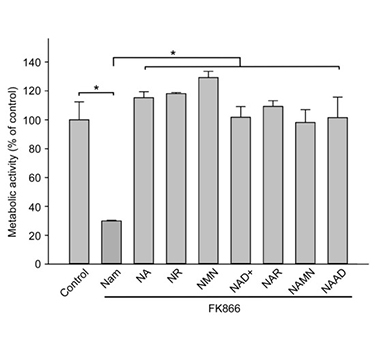- wzhou64@yahoo.com; sales@willynutra.com
- 1-240-401-4525 / 4000506055
- 10 Monona Court, Derwood, MD 20855, USA

This new research examines what happens to NR, NMN and other metabolites of NAD+ in the bloodstream and how they effect intracellular NAD+ levels in peripheral tissues.
Degradation of Extracellular NAD+ Intermediates in Cultures of Human HEK293 Cells(Nikiforov, dec 2019)
When added to the serum outside of cells, all NAD+ metabolites were effective at restoring the NAD+ levels and metabolic activity INSIDE the cells. NMN was the most effective.
Proponents of NR often point to studies that show NMN and NAD+ must be partially degraded to NR to cross the membrane of some cells, and claim this makes NR a better choice for supplementation.
The faster speed and effectiveness of NMN supplements has always made this position suspect. This research shows crossing the cellular membrane is not an impediment.
This research looked at kidney cells where NMN and NAD+ must be degraded to NR before crossing the cellular membrane.
Interestingly, the conversion does not seem to impact the ability to enter the cells.
They found that enzymes on the outside of the cells themselves (ecto-enzymes) perform this conversion and are ubiquitous.
For example, the ecto-enzyme CD73 can cleave NAD+ to NMN and AMP, and also dephosphorylate the NMN to NR and adenosine.
Researchers introduced various NAD+ metabolites to the serum outside of cells.
As shown in the chart above, adding NAD+ or it’s metabolites to the serum OUTSIDE the cells were all effective at restoring the NAD+ levels and metabolic activity INSIDE the cells.
In fact, NMN was by far the most effective at restoring metabolic activity INSIDE the cells.
This was in cells that NMN was supposedly disadvantaged by needing conversion to NR before crossing the cell membrane.
According to the authors:
Interestingly, exogenous nucleotides including NMN, NAMN, NAD+ and NAAD can support the maintenance of intracellular NAD pools as well as the nucleoside NR.
Moreover, the human ecto-enzyme CD73 has been described to catalyze both the cleavage of NAD+ to NMN and AMP as well as the subsequent dephosphorylation of the mononucleotides to the corresponding nucleosides, NR and adenosine.

Other studies such as the 2013 long term study by Mills show that in mice, NMN is taken up by cells throughout the body within 15 minutes.
The chart at left is from this 2019 study by Kristian.
It shows that NMN given to mice raise levels of NMN and NAD+ found in the blood plasma within 5 minutes, and reaches the hippocampus within 15 minutes.
NMN is quickly and efficiently utilized in all cells and tissues throughout the body.
Crossing the cellular membrane does not impede NMN.
NMN is more effective than other metabolites at restoring NAD+ levels inside of cells.